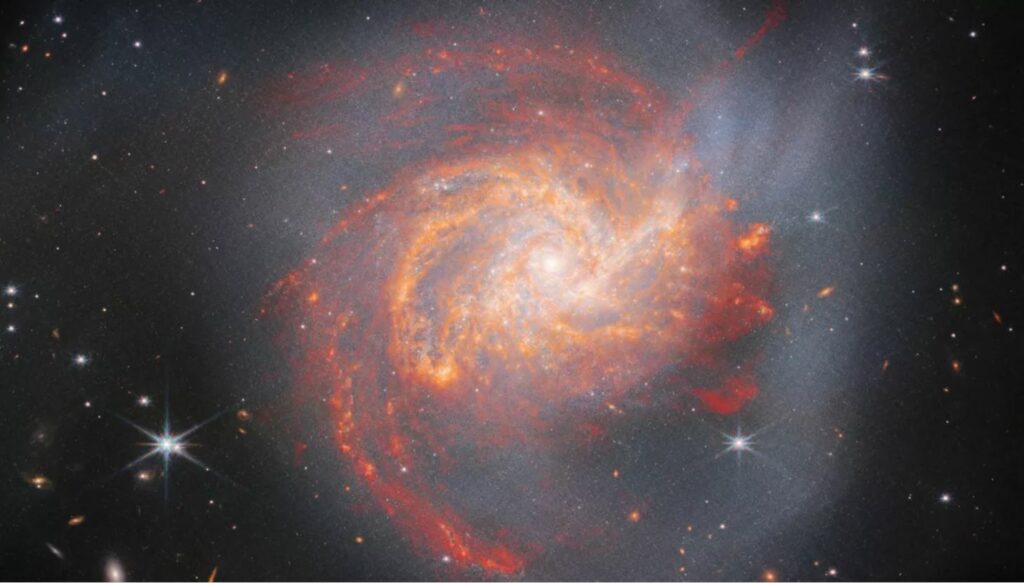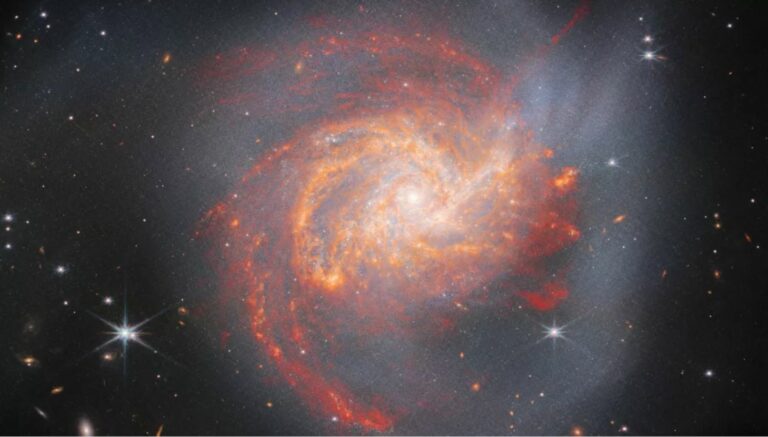Cosmic Clash of Celestial Titans Discovered by James Webb Space Telescope (Image)
A distant swirling galaxy imaged by the powerful space telescope may look serene but it has a violent past.
The latest image captured by the James Webb Space Telescope (JWST) challenges our perception of galaxies, revealing that appearances can be misleading.

Displayed within the picture is a seemingly tranquil orange-red galaxy, yet beneath its serene facade lies the aftermath of a colossal collision between two galaxies that occurred approximately 500 million years ago. This cosmic encounter left behind a chaotic spiral of gas, dust, and stars.
Designated as NGC 3256, this galaxy resides approximately 120 million light-years away from Earth and belongs to the Hydra-Centaurus Supercluster. Clues to its tumultuous history are concealed within the JWST image, manifested as extensive tendrils of luminous dust and stars that extend outward from the galaxy’s main body and its brightest regions.
The study of such cosmic collisions provides valuable insights into the growth of galaxies, including our own Milky Way, through mergers with other galaxies. By examining remnants like NGC 3256, astronomers can unravel the enigma surrounding the expansion of supermassive black holes at the cores of most galaxies, which grow to masses millions or even billions of times that of the sun as galaxies merge and evolve.
NGC 3256: A Celestial Fusion Fueling Stellar Birth and Unleashing Tidal Forces
The merger that forged NGC 3256 not only shaped its existence but also triggered an extraordinary surge in star formation within the galaxy. When galaxies collide, the convergence of gas and dust propels them into dense clouds, providing the essential building blocks for the birth of new stars.
Evident in the radiant orange-red glow of NGC 3256, the formation of young stars manifests as the brightest regions. These youthful stellar bodies emit intense infrared light, illuminating minuscule dust particles and causing the galaxy to emanate a resplendent glow. Consequently, this spectacle renders NGC 3256 an ideal target for the James Webb Space Telescope (JWST), purposefully designed to explore the universe in the infrared spectrum.
During galactic collisions, most stars remain relatively unscathed due to the vast voids between them. However, the fate of all stars within merging galaxies is not identical. The JWST image of NGC 3256 reveals threads of stars torn from their original galactic homes, a consequence of gravitational interactions and the resulting prodigious tidal forces.
Captivatingly, this awe-inspiring image of NGC 3256 materialized through the utilization of the JWST’s Near Infrared Camera (NIRCam) and Mid-Infrared Instrument (MIRI). By visualizing NGC 3256 in such detail, the power and significance of the JWST, the most advanced space telescope ever deployed around Earth, become evident in unraveling the intricacies of galactic growth and the evolutionary journey of our universe.
Do not forget to share your opinion with us to provide you with the best posts !




0 Comments